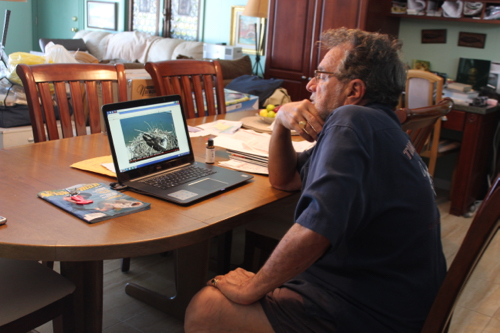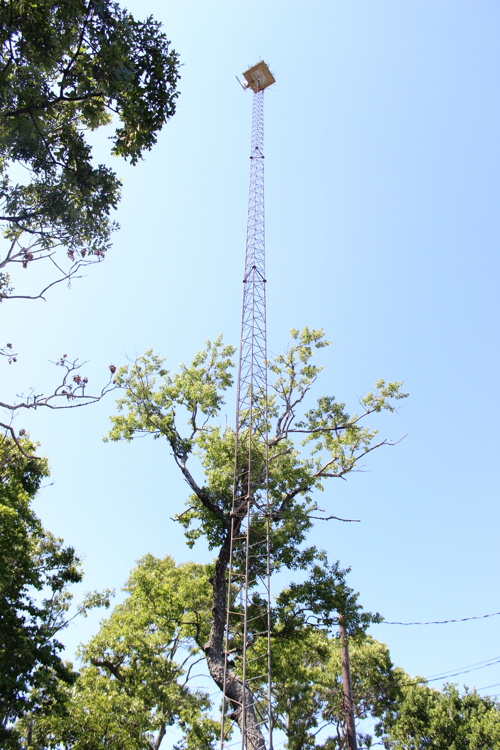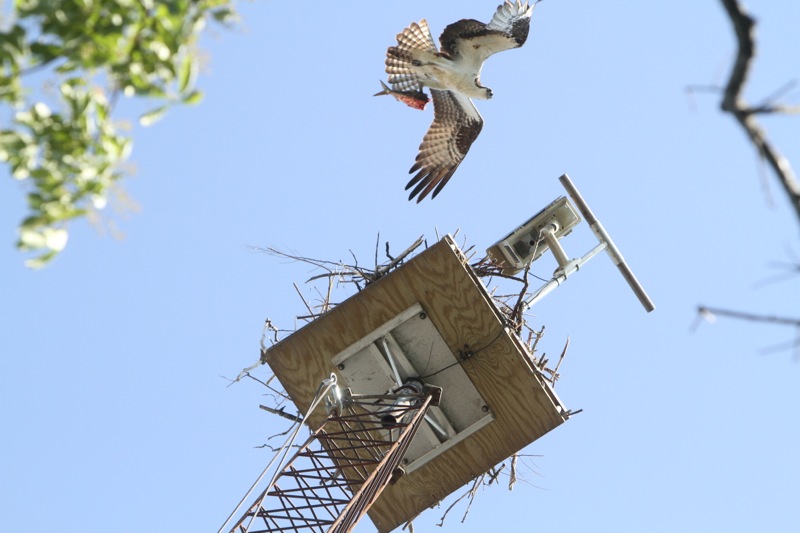A baby osprey hatched on live video in its nest in East Marion this morning, and its two siblings will be following suit over the next week.
And thanks to the efforts of some local nature enthusiasts, you can watch these once endangered birds and their babies right from your computer.
The website, ospreyzone.com, has drawn tens of thousands of visitors from all over the nation since its launch June 1. The live-streaming, high-definition video transports viewers to an osprey nest 80 feet above the ground, where a male and female osprey take turns sitting on the eggs, bringing back fish to share with one another and chirping in loud conversation.
And, as of this morning, a tiny baby osprey has joined its parents in the video, stretching its beak for food and nuzzling its mother.
“It’s addicting,” said Paul Henry, president of Tax Reduction Services, which built and sponsored the website. “It’s absolutely fascinating to watch.”
The nest is located on the East Marion property of Tommy Aprea, a retired commercial fisherman. Aprea built the 4×4 platform on top of his unused radio tower last summer after he noticed that an osprey seemed to have taken interest in the location.
“Every morning, I’d take the trash outside and see an osprey sitting on top of the tower, chirping at me,” Aprea said. “I thought, ‘Maybe he wants to build a nest there.’”
So he constructed a platform out of marine plywood and solicited a friend at North Fork Welding in Greenport to help him mount the platform to the top of the tower with a boom truck. On a whim, he decided to place a high-definition camera on a perch above the nest so that he and his friends could watch.
“Ten minutes after we put the platform up, there was a pair of ospreys on it,” Aprea said. “The truck hadn’t even left the driveway yet.”
The pair of ospreys, which Aprea has dubbed George and Gracie after the main characters from his favorite television show, were busy all last summer cultivating their nest with twigs, tree limbs, bones and seaweed. They left in September for the winter, but they were back in April, this time to lay three eggs.

“I started giving the video stream out to my friends,” he said. “People were crazy about it. But only 20 or 30 people would log on and it would crash.”
Enter Henry, the president of Tax Reduction Services but also a self-professed technology geek and nature lover.
“It’s hard not to be attracted to these birds,” Henry said. “You see them in the sky, and everyone says, ‘Oh, look – there’s an osprey!’ They’re quite magnificent.”
As soon as Henry learned of the nest and its camera, he became “instantly fascinated” with it. “It became clear to me that this was going to be quite popular, especially locally,” he said. “I wanted to make a website to share it with people.”
Henry set up web servers in his office where the video footage is sent from the camera and distributed onto the internet. He admits that the cost and effort of the project have been “pretty extreme,” but he says the value of a live video and audio stream of such rare, beautiful birds is more than worth it.
“I made a business decision to sponsor this website and pour resources into it,” he said. “The viewership overlapped with my audience for my company, but this is much more than any money or game. I knew that this is something people would really enjoy.”
He was right. Thousands of visitors tune in to watch Gracie and George every day, and that number has only kept growing. And just one look at the website’s comment section attests to the impact it has made on the community and beyond.
“Look at these,” Aprea said, scrolling down the list of messages from people around the country. “Look at all these people! We’re really doing something good here.”

“Thank u [sic] to whomever put up this site,” one comment reads. “My sister is mentally handicapped and she is getting so much joy watching these magnificent birds.”
“Thanks so much, however my office staff doesn’t get any work done since we have known about this site,” reads another comment from “Doc J.” “Fantastic look in to a life of the Osprey that we take for granted.”
Teachers have also been sharing the stream with their students, something Aprea feels is very important.
“Kids don’t know a lot about nature these days,” he said. “They don’t respect animals. It’s time they saw a site that’s educational.”
George and Gracie’s other two eggs are expected to hatch within the next week or two, Henry said. The camera will continue broadcasting their early days as they are fed, begin walking around and finally learn how to fly from the nest.
“We’ll keep streaming until they leave the nest in September,” he said. “Hopefully they come back.”
Meanwhile, Henry plans to spend the summer combing through the gargantuan amount of footage that has been stored since they began recording the birds. He hopes to use it for a documentary.
“It helps that the technology is so sophisticated,” he said. “The camera automatically saves high-resolution video when a certain level of motion is reached. We have days and days and days of video that we need to process and edit, but we really want to tell the story of this osprey family.”
Only half a century ago, ospreys were on the brink of extinction. Insecticides like DDT were poisoning osprey eggs, making them infertile or thin-shelled. After DDT was banned in 1972, however, osprey populations began to slowly climb to a stable level. The New York Department of Environmental Conservation downgraded them from “Endangered” to “Threatened” in 1983, and in 1999 to a species of “Special Concern,” which is their current status.
And for a bird that was almost completely wiped out in such recent memory, the chance to document the osprey’s comeback is that much more valuable, Henry says.
“It’s something I’ve always been fascinated with,” he said. “And beyond that, they’re just such beautiful birds. Beautiful and born free.”
The survival of local journalism depends on your support.
We are a small family-owned operation. You rely on us to stay informed, and we depend on you to make our work possible. Just a few dollars can help us continue to bring this important service to our community.
Support RiverheadLOCAL today.
































